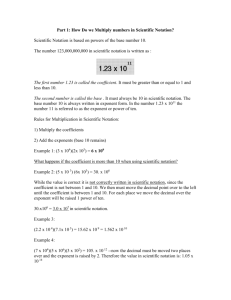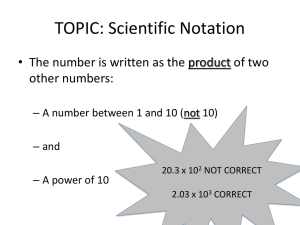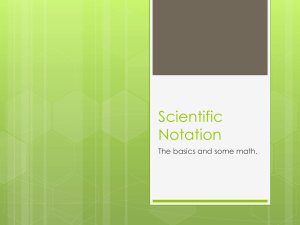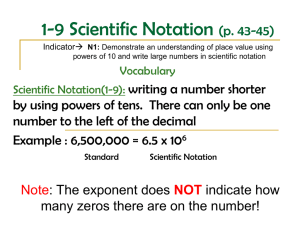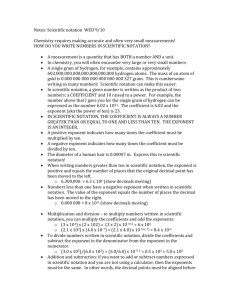Section 5.1
advertisement
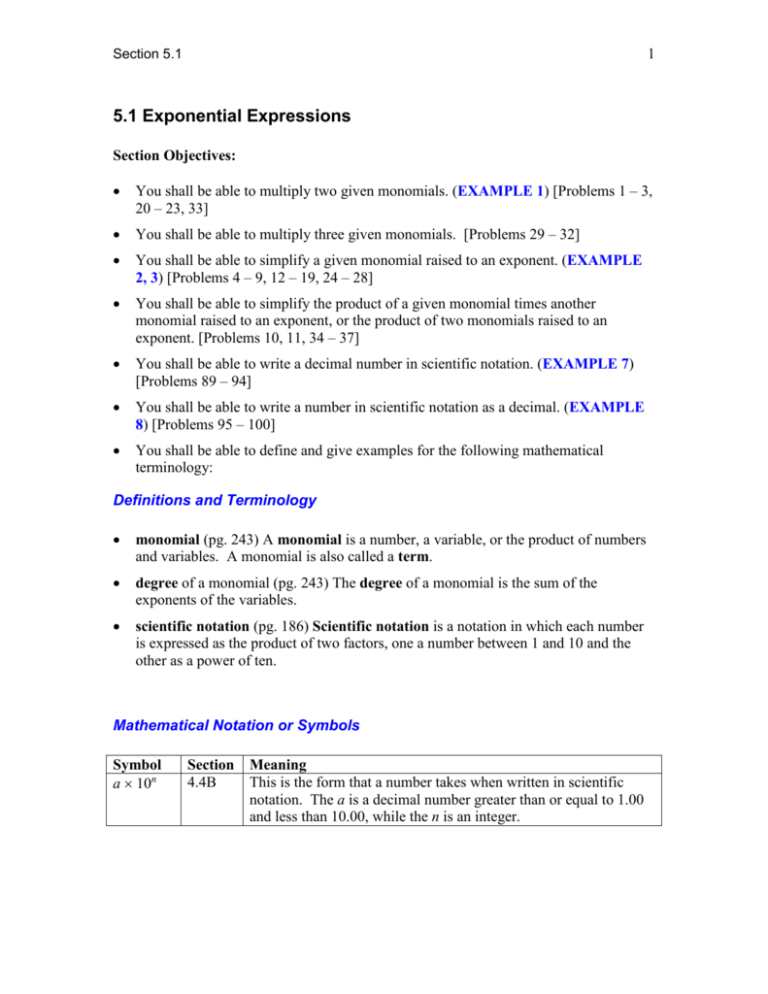
1 Section 5.1 5.1 Exponential Expressions Section Objectives: You shall be able to multiply two given monomials. (EXAMPLE 1) [Problems 1 – 3, 20 – 23, 33] You shall be able to multiply three given monomials. [Problems 29 – 32] You shall be able to simplify a given monomial raised to an exponent. (EXAMPLE 2, 3) [Problems 4 – 9, 12 – 19, 24 – 28] You shall be able to simplify the product of a given monomial times another monomial raised to an exponent, or the product of two monomials raised to an exponent. [Problems 10, 11, 34 – 37] You shall be able to write a decimal number in scientific notation. (EXAMPLE 7) [Problems 89 – 94] You shall be able to write a number in scientific notation as a decimal. (EXAMPLE 8) [Problems 95 – 100] You shall be able to define and give examples for the following mathematical terminology: Definitions and Terminology monomial (pg. 243) A monomial is a number, a variable, or the product of numbers and variables. A monomial is also called a term. degree of a monomial (pg. 243) The degree of a monomial is the sum of the exponents of the variables. scientific notation (pg. 186) Scientific notation is a notation in which each number is expressed as the product of two factors, one a number between 1 and 10 and the other as a power of ten. Mathematical Notation or Symbols Symbol a 10n Section 4.4B Meaning This is the form that a number takes when written in scientific notation. The a is a decimal number greater than or equal to 1.00 and less than 10.00, while the n is an integer. Section 5.1 2 Concepts, Facts, Theorems – Objective A You shall be able to multiply two given monomials. (EXAMPLE 1) [Problems 1 – 3, 20 – 23, 33] You shall be able to multiply three given monomials. [Problems 29 – 32] Process to Multiply Monomials 1. For each term being multiplied, ensure that each term has a coefficient. If a term is missing the coefficient, place a 1 or 1 in front of the variables. 2. For each term being multiplied, ensure that every variable has an exponent. If there is no exponent, give that variable an exponent of 1. 3. Multiply all of the coefficients in front of the variables and place that as the first part of your answer. 4. For each different variable, add up all of its associated exponents across all of the terms being multiplied. The variables should appear immediately following the coefficient in your answer. The variables are usually written in alphabetical order. You shall be able to simplify a given monomial raised to an exponent. (EXAMPLE 2, 3) [Problems 4 – 9, 12 – 19, 24 – 28] Process to Simplify Powers of Monomials 1. Ensure that the monomial has a coefficient. If the monomial is missing the coefficient, place a 1 or 1 (depending upon the sign) in front of the variables. 2. Ensure that the coefficient has an exponent. If there is no exponent, give the coefficient an exponent of 1. 3. Ensure that every variable has an exponent. If there is no exponent, give that variable an exponent of 1. 4. Place parentheses around the coefficient of the monomial and take the exponent on the outside of the parenthesis and use it as the exponent of the coefficient. Simplify this to a single number. 5. Multiply the exponent on the outside of the parenthesis times each of the exponents on the inside of the parentheses. Simplify the coefficient by multiplying itself by the number of times indicated in the exponent. 6. The coefficient should appear first in your final answer. The variables should appear immediately following the coefficient in your answer. The variables are usually written in alphabetical order. 3 Section 5.1 You shall be able to simplify the product of a given monomial times another monomial raised to an exponent, or the product of two monomials raised to an exponent. [Problems 10, 11, 34 – 37] To solve these problems, perform the following processes in the given order: For any terms in the product that involve powers, simplify them by using the Process to Simplify Powers of Monomials Next, perform the multiplication after completing the step above by using the Process to Multiply Monomials Homework – Objective A Example A Example B Concepts, Facts, Theorems – Objective B Powers of 10 Negative Powers of 10: 101 = 0.1; 102 = 0.01; 103 = 0.001; 104 = 0.0001; … Thus, Negative Powers of 10 are SMALL Numbers. 10 to the Zero Power: 100 = 1 Positive Powers of 10: 101 = 0.1; 102 = 0.01; 103 = 0.001; 104 = 0.0001; … Thus, Positive Powers of 10 are LARGE Numbers. Scientific Notation A number is in scientific notation if and only if it is written in the following form: a 10n, where 1) a is a decimal number greater than or equal to 1.00 and less than 10.00, 2) the second number in the product is a power of 10 (the base = 10), and 3) n is an integer. 4 Section 5.1 Are these number in Scientific Notation? Number 2.3 100 .47 105 6.5 114 8.36 1017 14.2 104 Yes/No Yes No No Yes No Reason 2.3 is greater than 1 and less than 10; 0 is an integer .47 < 1.00 The second part must have a base of 10. 14.2 > 10 You shall be able to write a decimal number in scientific notation. (EXAMPLE 4) [Problems 97 – 105] Process to Convert a Decimal to Scientific Notation 1. For numbers greater than or equal to 10, move the decimal point to the right of the first digit. The exponent n is positive and equal to the number of places the decimal point has been moved. 2. For numbers less than 1, move the decimal point to the right of the first nonzero digit. The exponent n is negative. The absolute value of the exponent is equal to the number of places the decimal point has been moved. You shall be able to write a number in scientific notation as a decimal. (EXAMPLE 5) [Problems 106 – 114] Process to Convert a number in Scientific Notation to a Decimal 1. When exponent n is positive, move the decimal point to the right the same number of places as the exponent. 2. When exponent n is negative, move the decimal point to the left the same number of places as the absolute value of the exponent. Example A Convert 0.00000076 to scientific notation. Convert 76000000 to scientific notation. Example B Convert 4.3 108 to decimal notation. Convert 4.3 108 to decimal notation.

